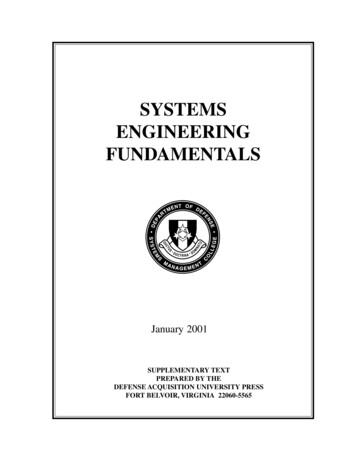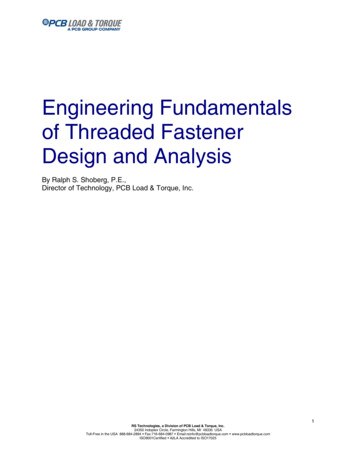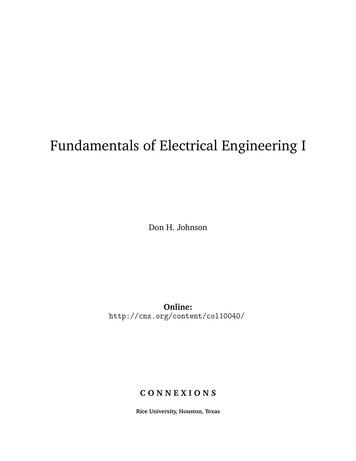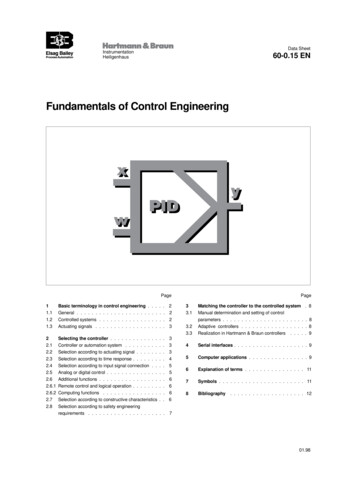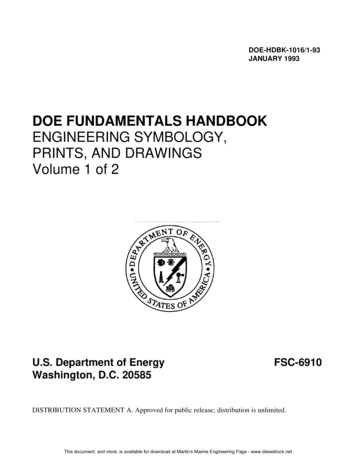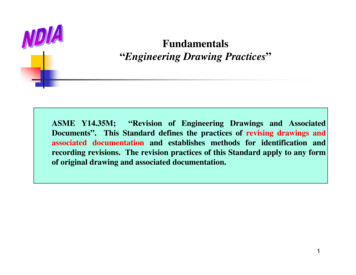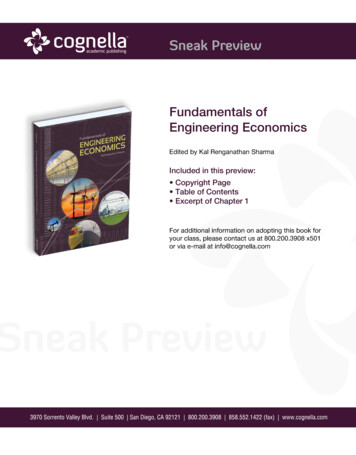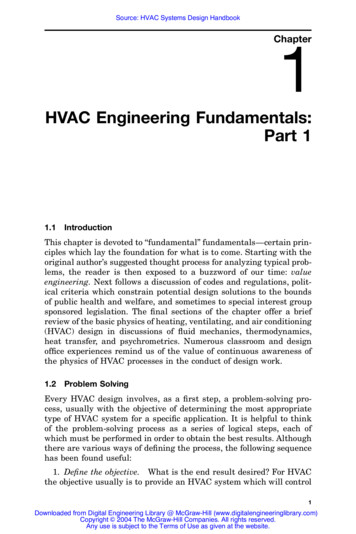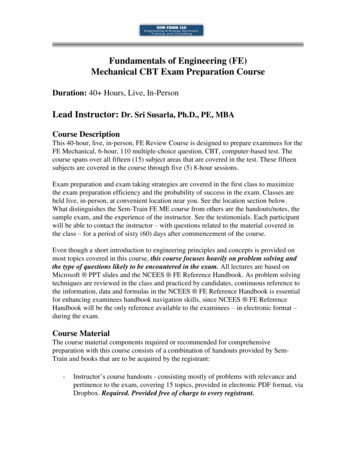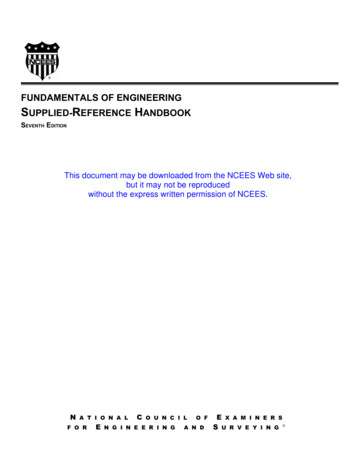
Transcription
FUNDAMENTALS OF ENGINEERINGSUPPLIED-REFERENCE HANDBOOKSEVENTH EDITIONThis document may be downloaded from the NCEES Web site,but it may not be reproducedwithout the express written permission of NCEES.NA T I O N A LF O RECO U N C I LN G I N E E R I N GO FA N DE X A M I N E R SS U R V E Y I N G
FUNDAMENTALS OF ENGINEERINGSUPPLIED-REFERENCE HANDBOOKSEVENTH EDITION
Published by theNational Council of Examiners for Engineering and Surveying 280 Seneca Creek Road, Clemson, SC 29631800-250-3196www.ncees.org 2005 by the National Council of Examiners for Engineering and Surveying . All rights reserved.ISBN 1-932613-19-6Printed in the United States of AmericaMay 2005
PREFACEThe Fundamentals of Engineering (FE) Supplied-Reference Handbook is the only reference material allowed inthe FE examination. Many examinees find that it is helpful to review this book before exam day to becomefamiliar with the reference material it contains. If you have purchased or downloaded the Reference Handbookbefore the examination, you will not be allowed to take it with you into the exam room. Instead, theexamination proctor will issue a new copy to each examinee shortly before testing begins. During the exam, youare allowed to write only on your answer sheet and in your exam book; you may not write in the ReferenceHandbook since it is often retained by universities and used for study purposes.The Reference Handbook contains only reference formulas and tables; it does not contain sample examinationquestions. Many commercially available books contain worked examples and sample questions to help youprepare for the examination. NCEES provides sample questions and solutions in various formats to help youbecome familiar with the types of exam questions and the level of difficulty of the examination.The Reference Handbook is not designed to assist in all parts of the FE examination. For example, some of thebasic theories, conversion, formulas, and definitions that examinees are expected to know are not included.Special material required for the solution of a particular examination question will be included in the questionstatement itself.In no event will NCEES be liable for not providing reference material to support all the questions in the FEexamination. In the interest of constant improvement, NCEES reserves the right to revise and update the FESupplied-Reference Handbook as it deems appropriate without informing interested parties. Each NCEES FEexamination will be administered using the latest version of the FE Supplied-Reference Handbook.To report suspected errata for this book, please e-mail your correction using our online feedback form. Erratawill be posted on our Web site. Examinees are not penalized for any errors in the Reference Handbook thataffect an examination question.UPDATES TO EXAMINATION INFORMATIONFor current exam specifications, study materials and errata, a list ofcalculators that may be used at the exam, guidelines for requesting specialtesting accommodations, and other information about exams and licensure,visit the NCEES Web site at www.ncees.org or call us at 800-250-3196.iii
CONTENTSUnits.1Conversion Factors .2Mathematics.3Engineering Probability and Statistics .15Statics.24Dynamics .29Mechanics of Materials.38Fluid Mechanics.44Thermodynamics.56Heat Transfer .67Transport Phenomena .73Biology.74Chemistry.78Materials Science/Structure of Matter .82Measurement and Controls .87Computer Spreadsheets.91Engineering Economics .92Ethics.99Chemical Engineering.101Civil Engineering .111Environmental Engineering .143Electrical and Computer Engineering.167Industrial Engineering.189Mechanical Engineering .203Index .219School/Institution Codes.226v
UNITSThis handbook uses the metric system of units. Ultimately, the FE examination will be entirely metric. However, currently someof the problems use both metric and U.S. Customary System (USCS). In the USCS system of units, both force and mass arecalled pounds. Therefore, one must distinguish the pound-force (lbf) from the pound-mass (lbm).The pound-force is that force which accelerates one pound-mass at 32.174 ft/s2. Thus, 1 lbf 32.174 lbm-ft/s2. The expression32.174 lbm-ft/(lbf-s2) is designated as gc and is used to resolve expressions involving both mass and force expressed as pounds.For instance, in writing Newton's second law, the equation would be written as F ma/gc, where F is in lbf, m in lbm, and a isin ft/s2.Similar expressions exist for other quantities. Kinetic Energy: KE mv2/2gc, with KE in (ft-lbf); Potential Energy: PE mgh/gc,with PE in (ft-lbf); Fluid Pressure: p ρgh/gc, with p in (lbf/ft2); Specific Weight: SW ρg/gc, in (lbf/ft3); Shear Stress: τ (µ/gc)(dv/dy), with shear stress in (lbf/ft2). In all these examples, gc should be regarded as a unit conversion factor. It isfrequently not written explicitly in engineering equations. However, its use is required to produce a consistent set of units.Note that the conversion factor gc [lbm-ft/(lbf-s2)] should not be confused with the local acceleration of gravity g, which hasdifferent units (m/s2 or ft/s2)and may be either its standard value (9.807 m/s2 or 32.174 ft/s2) or some other local value.If the problem is presented in USCS units, it may be necessary to use the constant gc in the equation to have a consistent set ofunits.MultipleMETRIC erapetaexaCOMMONLY USED EQUIVALENTSSymbolafpnµ1 gallon of water weighs1 cubic foot of water weighs1 cubic inch of mercury weighs8.34 lbf62.4 lbf0.491 lbfThe mass of one cubic meter of water is 1,000 kilogramsmcddahkMGTPETEMPERATURE CONVERSIONSºF 1.8 (ºC) 32ºC (ºF – 32)/1.8ºR ºF 459.69K ºC 273.15FUNDAMENTAL CONSTANTSQuantitySymbolValueelectron chargee1.6022 10 1996,485Faraday constantR8,314gas constantmetricR8.314gas constantmetricR1,545gas constantUSCSR0.08206gravitation - newtonian constantG6.673 10–11gravitation - newtonian constantG6.673 10–11gravity acceleration (standard)metricg9.807gravity acceleration (standard)USCSg32.17422,414molar volume (ideal gas), T 273.15K, p 101.3 kPaVmspeed of light in vacuumc299,792,000Stephan-Boltzmann constantσ5.67 10–81UnitsC K)ft-lbf/(lb L/kmolm/sW/(m2·K4)
CONVERSION FACTORSMultiplyacreampere-hr (A-hr)ångström (Å)atmosphere (atm)atm, stdatm, stdatm, stdatm, stdBy43,5603,6001 10–1076.029.9214.7033.901.013 105barbarrels–oilBtuBtuBtuBtu/hrBtu/hrBtu/hr1 105421,055calorie (g-cal)calcalcal/seccentimeter (cm)cmcentipoise (cP)centistokes (cSt)cubic feet/second (cfs)3.968 10–31.560 10–64.1864.186cubic foot (ft3)cubic meters (m3)electronvolt (eV)foot (ft)ftft-pound (ft-lbf)ft-lbfft-lbfft-lbfft-lbf/sec2.928 10–47783.930 10–40.2930.2163.281 10–20.3940.0011 10–60.6463177.4811,0001.602 10–1930.480.30481.285 10–33.766 10–70.3241.3561.818 10–3To ObtainMultiplysquare feet (ft2)coulomb (C)meter (m)cm, mercury (Hg)in, mercury (Hg)lbf/in2 abs (psia)ft, waterpascal (Pa)Pagallons–oiljoule (J)kilowatt-hr (kWh)ft-lbfhorsepower (hp)watt (W)ft-lbf/secBtuhp-hrjoule (J)watt (W)foot (ft)inch (in)pascal·sec (Pa·s)m2/sec (m2/s)million gallons/day (mgd)gallonLitersjoule (J)cmmeter (m)Btukilowatt-hr (kWh)calorie (g-cal)joule (J)horsepower (hp)gallon (US Liq)gallon (US Liq)gallons of water3.7850.1348.3453liter (L)ft3pounds of watertesla (T)Tpound (lbm)gamma (γ, Γ)gaussgram (g)1 10–91 10–42.205 10–3hectarehectarehorsepower (hp)hphphphp-hrhp-hrhp-hrhp-hr1 1042.4710442.4745.733,0005502,5441.98 1062.68 1060.746square meters (m2)acresBtu/minwatt (W)(ft-lbf)/min(ft-lbf)/secBtuft-lbfjoule (J)kWhinch (in)in of Hgin of Hgin of H2Oin of H2O2.5400.033413.600.03610.002458centimeter (cm)atmin of H2Olbf/in2 (psi)atm2ByTo Obtainjoule (J)JJJ/s9.478 10–40.737611Btuft-lbfnewton·m (N·m)watt (W)kilogram (kg)kgfkilometer (km)km/hrkilopascal (kPa)kilowatt (kW)kWkWkW-hour (kWh)kWhkWhkip 1.3413.6 1061,0004,448pound (lbm)newton (N)feet (ft)mphlbf/in2 (psi)horsepower (hp)Btu/hr(ft-lbf )/secBtuhp-hrjoule (J)lbfnewton (N)liter (L)LLL/second (L/s)L/s61.020.26410–32.11915.85in3gal (US Liq)m3ft3/min (cfm)gal (US)/min (gpm)meter (m)m3.2811.094feet (ft)yardmetric tonm/second (m/s)mile (statute)mile (statute)mile/hour (mph)mphmm of Hgmm of H2O1,000196.85,2801.60988.01.6091.316 10–39.678 10–5kilogram (kg)feet/min (ft/min)feet (ft)kilometer (km)ft/min (fpm)km/hatmatmnewton (N)N·mN·m0.2250.73761lbfft-lbfjoule (J)pascal (Pa)PaPa·sec (Pa·s)pound (lbm,avdp)lbflbf-ftlbf/in2 (psi)psipsipsi9.869 here (atm)newton/m2 (N/m2)poise (P)kilogram (kg)NN·matmft of H2Oin of HgParadian180/πdegreestokes1 10–4m2/stherm1 105Btuwatt (W)WWweber/m2 (Wb/m2)3.4131.341 10–3110,000Btu/hrhorsepower (hp)joule/sec (J/s)gauss
MATHEMATICSCase 2. Ellipse STRAIGHT LINEThe general form of the equation ise 1:Ax By C 0The standard form of the equation isy mx b,which is also known as the slope-intercept form.The point-slope form isy – y1 m(x – x1)Given two points: slope,m (y2 – y1)/(x2 – x1)The angle between lines with slopes m1 and m2 isα arctan [(m2 – m1)/(1 m2·m1)]Two lines are perpendicular if(x h )2 ( y k )2m1 –1/m2a2The distance between two points isd ( y 2 y1 )2 1; Center at (h , k )is the standard form of the equation. When h k 0, (x2 x1 )2()e 1 b2 a2 c / aEccentricity:QUADRATIC EQUATIONax2 bx c 0b a 1 e2 ;Focus: ( ae ,0); b b 2 4acRoots 2aDirectrix: x a / eCase 3. Hyperbolae 1: CONIC SECTIONS( x h)2 ( y k)2 1; Center at ( h, k )a2b2is the standard form of the equation. When h k 0,e eccentricity cos θ/(cos φ)[Note: X′ and Y′, in the following cases, are translatedaxes.]Case 1. Parabola b2Eccentricity:e 1:()e 1 b2 a 2 c / ab a e2 1;Focus: ( ae, 0) ; Directrix: x a / e Brink, R.W., A First Year of College Mathematics, D. Appleton-Century Co., Inc., 1937.(y – k)2 2p(x – h); Center at (h, k)is the standard form of the equation. When h k 0,Focus: (p/2,0); Directrix: x –p/23
MATHEMATICS (continued)h –a; k –bCase 4. Circle e 0:(x – h)2 (y – k)2 r2;Center at (h, k)is the general form of the equation with radiusr (x h )2r a2 b2 cIf a2 b2 – c is positive, a circle, center (–a, –b). (y k )2If a2 b2 – c equals zero, a point at (–a, –b).If a2 b2 – c is negative, locus is imaginary. QUADRIC SURFACE (SPHERE)The general form of the equation is(x – h)2 (y – k)2 (z – m)2 r2with center at (h, k, m).In a three-dimensional space, the distance between twopoints isd Length of the tangent from a point. Using the general formof the equation of a circle, the length of the tangent is foundfrom(x2 x1 )2 ( y 2 y1 )2 (z 2 z1 )2LOGARITHMSThe logarithm of x to the Base b is defined bylogb (x) c, wheret2 (x′ – h)2 (y′ – k)2 – r2bc xSpecial definitions for b e or b
This handbook uses the metric system of units. Ultimately, the FE examination will be entirely metric. However, currently some of the problems use both metric and U.S.



